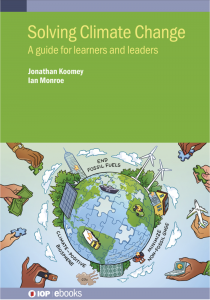Solving Climate Change
Reviewed by Jungwoo Chun, Massachusetts Institute of Technology
What can governments, companies, individual consumers and investors do now to reduce emissions rapidly and how can we organize this collective action based on informed consent (and commitment) across different jurisdictional and geographic contexts?
Solving Climate Change: A Guide for Learners and Leaders, by Jonathan Koomey and Ian Monroe, Iop Publishing Ltd, 2023, 350 pp.
As the title of the volume suggests, Solving Climate Change: A Guide for Learners and Leaders by Jonathan Koomey and Ian Monroe provides a comprehensive yet concise overview of what we know and what needs to be done now to stop climate change. Although the authors indicate that the book is primarily designed for an academic audience (including advanced students), in my view, it is equally suitable for anyone who wants to learn and begin to think about specific actionable items.
What I find most helpful as a reader is chapter 3 that introduces some of the tools that are most widely practiced in planning strategies based on future forecasts, which rely on existing inventories. Readers who want to take a deeper dive at a particular tool can look them up online or read other materials. This chapter in particular could serve as a guidebook for those who aren’t familiar with the palette of tools not unique to a specific area of expertise or discipline.
The book is conveniently organized by the so-called eight pillars of climate action: (1) electrify almost everything, (2) decarbonize the grid, (3) reduce non-fossil GHGs, (4) be efficient, (5) get rid of carbon, (6) align incentives, (7) move money from climate-negative activities to climate-positive ones and (8) fight misinformation. The authors do an excellent job of pulling together all of these critical strategies in an easily digestible manner. In closing, they point out what each of the key constituents (governments, companies, individual consumers and investors) will have to do now to reduce emissions rapidly. The under-explored question in my view is how. Governments can incentivize climate-positive behaviour but that won’t be enough to trigger a transformative change. Unfortunately, perhaps the world needs another crisis resulting in millions in casualties. Miserable events that are so catastrophic at scale that might awaken everyone.
Koomey and Monroe in many ways reassure us that we have what it takes to stop emissions. The problem is we cannot achieve this with only a subset of us taking action. How to get the majority to uniformly take action across different interest groups seems to be a policy and planning question that requires careful process design – how to get all stakeholders to take concerted action that is jointly motivated and agreed upon. How to organize this collective action based on informed consent (and commitment) across different jurisdictional and geographic contexts seems to be the next topic area that deserves unprecedented attention before it’s too late.





